We have a hunting act in Finland that obligates you to keep your dog on a leash from 1st March onwards. The act is intended to provide peace and space for wildlife to freely breed and raise their offspring. Even if your dog isn’t a hunting dog, animals will still view any dog as a predator, which means that their presence may disturb nesting and even lead to abandoned nests. This is especially fateful for endangered species. The leashing period (kiinnipitoaika in Finnish) lasts from the 1st March until 19th August. During this period, dogs must be always kept on a leash when outdoors, or kept so that they may be immediately put on a leash. This doesn’t mean that your dog can roam around freely and you can call it to you; it means the dog can be put immediately on a leash. However, on private yards, gardens, or other fenced areas are free for dogs to roam around in as long as you have the permission of the owner.
In Finland, national parks are meant for both people but also for animals and plants. In national parks, dogs must be on a leash at all times of the year even outside the leashing period so that the animals and plants are safe.
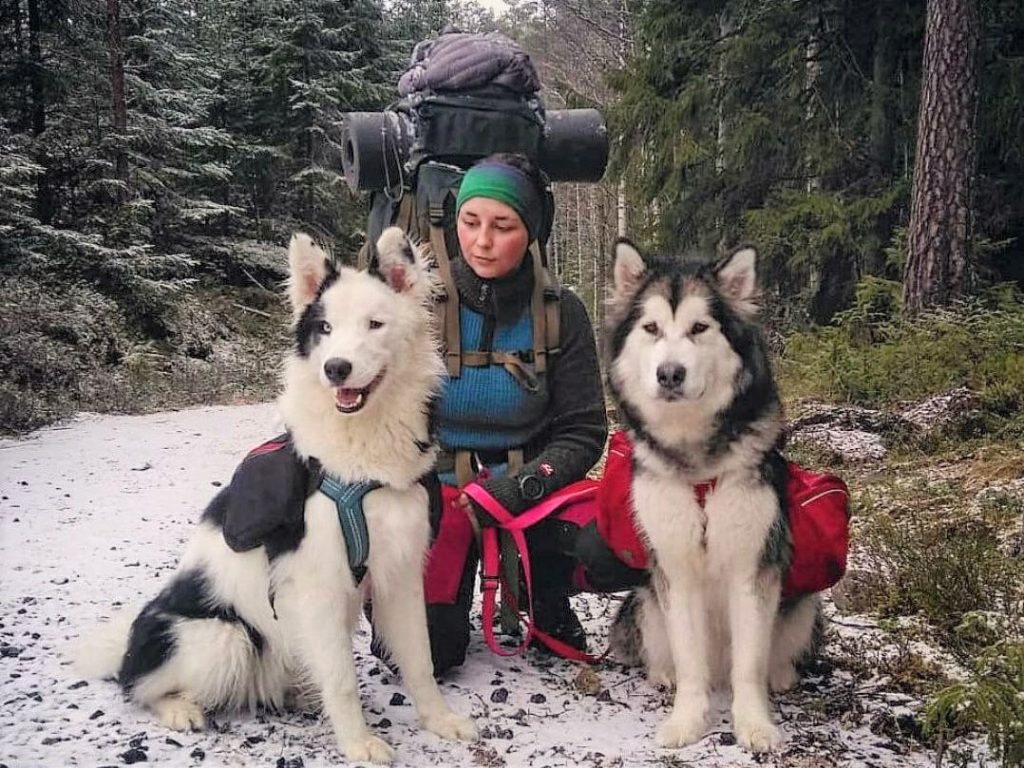
Hiking and dogs, my two loves
I have always been a dog person, so I’ve long had dogs with me when camping and hiking. Hiking and trekking is another thing close to my heart, and this is one of the reasons how I’ve chosen the breeds of my dogs. A dog’s breed is especially important to consider if you’re into hiking and trekking. The energy levels of the dog, how long they can go on for, are they interested in walking, their size and ability to walk in all terrains, even their fur quality which has to do with their ability to withstand the cold in poor weather conditions.
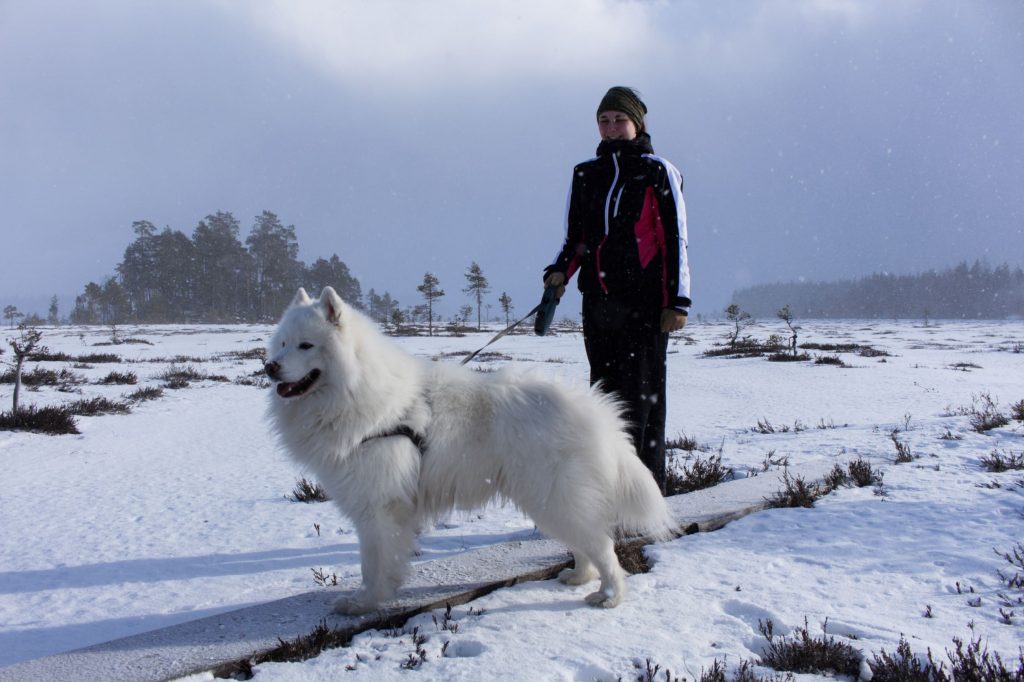
My first dog was a Samoyed, a great choice for my first dog as well as a companion on treks. Samoyeds are relatively easy to train, and their fur is also weather-resistant, so I didn’t have to worry about the cold or the rain. I have always liked the independence of arctic and sled dogs and their comfort at not having to burrow in your armpit at all times.
Dog training tips
As soon as I get a new dog in my house, I have almost always started to get them comfortable in the woods and hiking. Dogs are fast learners so even if you start at a later age, it’s no problem. Here’s a good checklist for you to keep track of what to teach the dog before you go on a hike:
- Get your dog used to wearing shoes or socks. In case your dog has an issue with its paw during hiking, it is good to always have a dog’s sock or shoe with you.
- Teach your dog to cross waterways or to go into water when commanded.
- It is good to teach your dog to walk behind you when going downhill! A heavy backpack on a dog and on yourself may cause an accident if your dog suddenly yanks you down.
- Get your dog used to different terrains. Slippery rocks, blockfields, ice, snow, forest floors. Their paws will get used to them quickly, and you will end up having less issues with injuries!
- It’s good to teach a spirited dog to calm itself down during breaks so that their energy consumption remains level.
- Teach your dog to sleep in a tent.
- Get your dog used to being held and lifted (as long as their weight allows), because if something happens during the hike, it’s good to have a backup plan on how you will get your dog back home.
- Get your dog accustomed to a backpack by putting an empty backpack or training pack on them during normal walks. (NB. Don’t put any weights in if your dog is still growing so that it doesn’t affect their bone growth.)
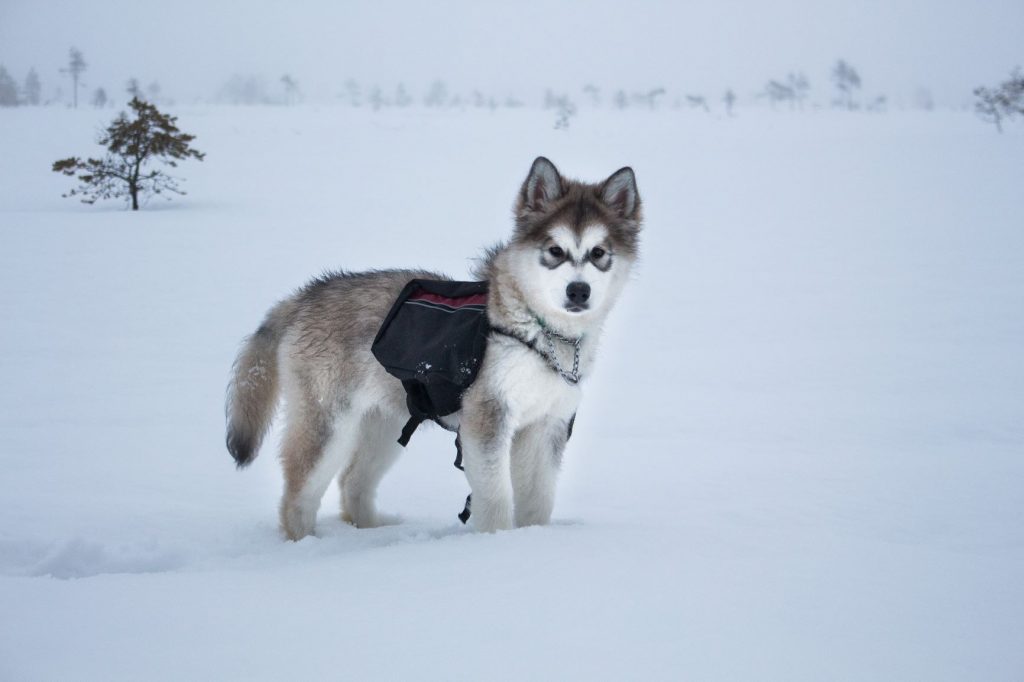
Until my dogs have reached two years, I have only put an empty training pack on my puppies so that the weight of the pack remains extremely light. This is my way of making sure the weight of the pack doesn’t affect their bone growth in any way. When the dog is more used to carrying the pack and they are old enough, we have switched to the Palisades pack by Ruffwear. This pack has a large enough span to tighten the circumference if your dog gains or loses weight, or even if they shed their winter fur. The pack is also weatherproof, and it has the perfect volume, meaning that my dog has been able to carry its own food even for a whole week.
A dog can basically carry about 25% of its own body weight. You should slowly increase the weights in the packs, so that it can get used to the load.
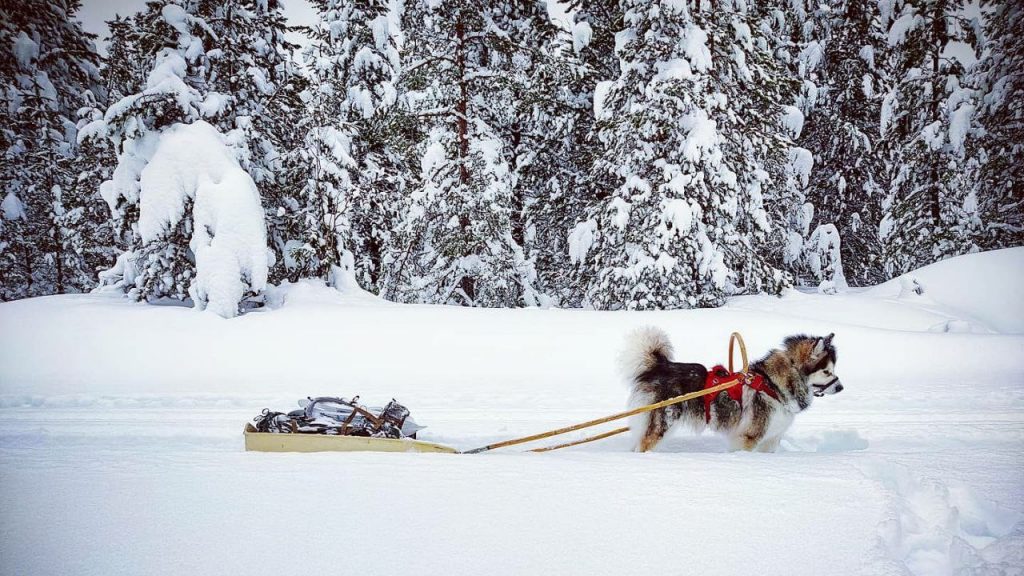
What to take with you when going hiking with a dog?
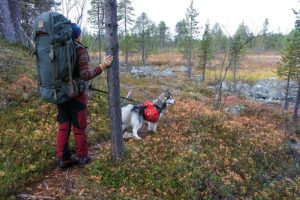
- Paw balm! I have always taken with me some honey balm by Vetramil because it is simply very good.
- I have also taken Vetriderm solution with me because it both cleanses and soothes dried skin.
- I normally pack the same amount of food for my dog as it would consume during a normal day. However, you need to remember that the dog’s energy consumption is higher while in the woods and on hikes, so extra food is necessary. I have always thought a good solution is to have some extra food for yourself and feeding any leftovers to your dog. Then you have emergency rations for both of you in case something happens and you have to stay an extra night out.
- I always have a miniature emergency kit in my dog’s pack because if I happen to fall somewhere, it is more likely that a dog can get to me easier than another human being.
- There is also a normal sock and a scrunchie in the dog’s pack. In case of a paw injury, I can put on the paw balm and then a sock on top of it. Then it’s easy to tighten the pack with the scrunchie.
- Tweezers in case of ticks is a must.
- Clothes or a weatherproof suit for your dog in case their fur is not weather-resistant.
Hikes and treks should be undertaken on the terms of your dog. This way makes it much more enjoyable for both of you! Learn to recognise even the smallest behaviours when you are hiking with a dog so you know if your dog is behaving abnormally – it might indicate a snake bite or something else.
Few examples from hiking with a dog
My trust in my Alaskan Malamute called Viima is firm like a rock. Viima has never been an especially good housedog because its energy levels are off the charts. Training has also been a challenge because it doesn’t have any interest in toys, food makes it hyper, and outside it can’t concentrate on even walking on a leash. However, when we are out in the nature, Viima’s mind is human-like, just like the mind of my late Samoyed Welho. Viima knows when it’s time to work, and its work motivation is incredible. During joring or hikes it never allows for anything to distract its work.
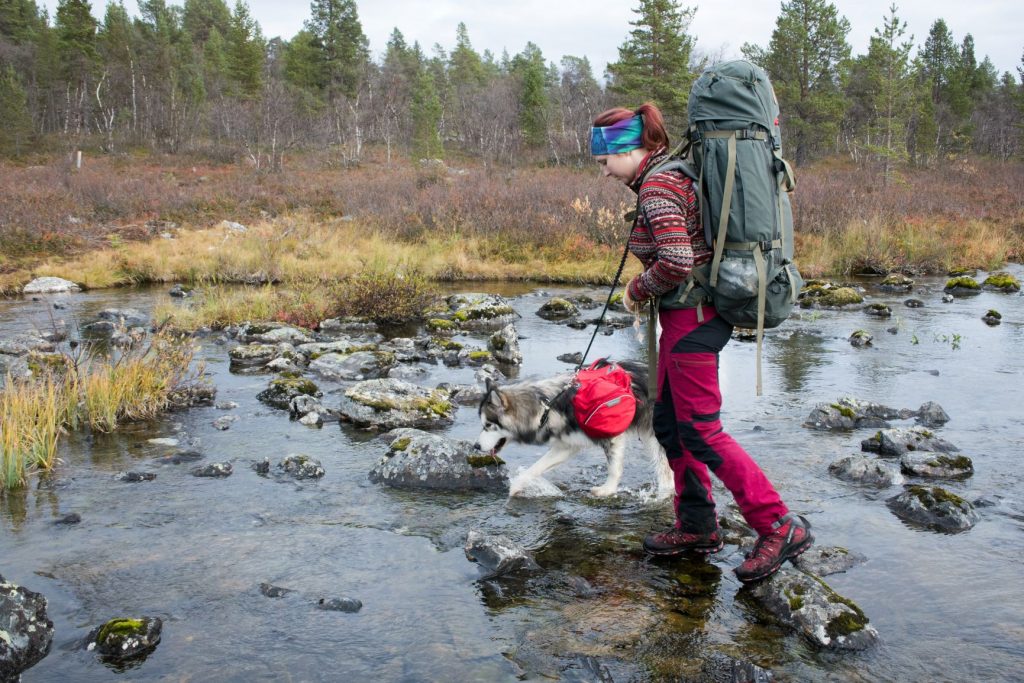
When going downhill, Viima mainly sets itself behind me or next to me in case I need support against slipping. Viima knows when my blood sugar is low, so it knows to bark and tell me to stop and eat – I never really notice the hunger myself. When we were hiking at the Kaldoaivi wilderness area at the northernmost tip of Finland, Viima sensed a bear near us long before we did. Viima kept itself between us and the bear the entire trek. There was no danger to any of us but Viima clearly wanted to ensure that nothing happened. When we got to the wilderness hut, Viima guarded the door as long as the bear was in the vicinity. Last winter at Isojärvi national park, Viima picked up some pine branches from the forest and lay on top of them to sleep so that its fur would stay dry.
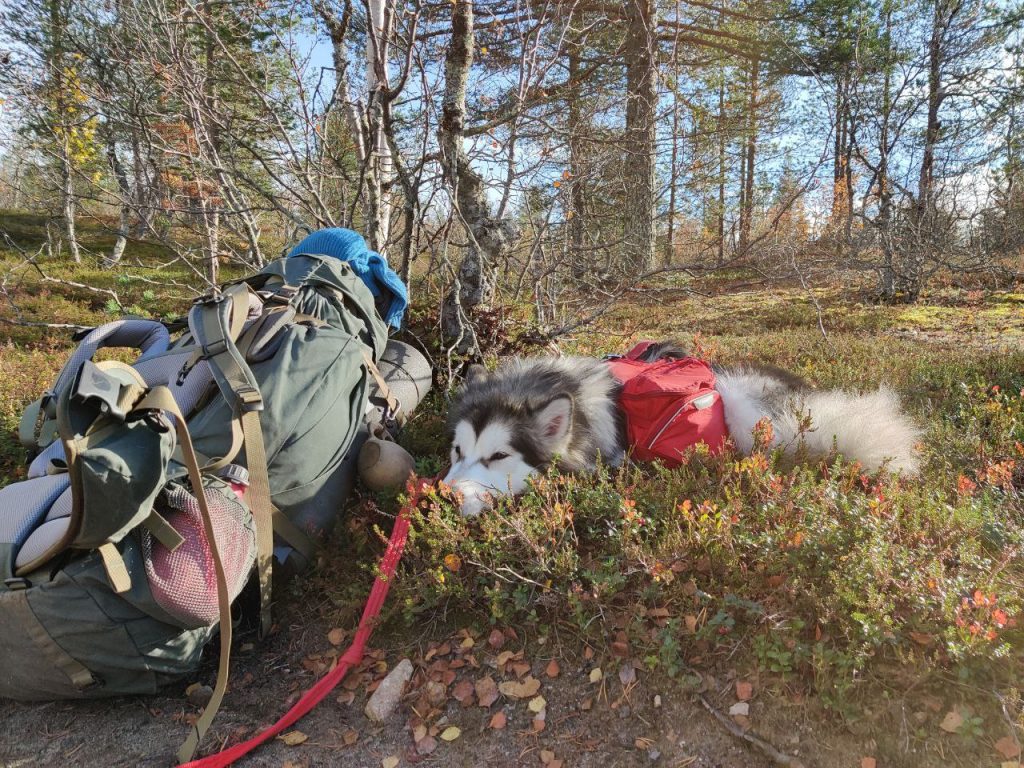
I have hundreds of examples to give you from hiking with a dog, but it all boils down to the fact that I trust my dog’s instincts much more than I do my own. My trust has only increased when I have gotten to know its gestures from even the slightest change. I’ve also learned to do things on the terms of my dog: if my dog decides that it wants a day off, that’s what we will do. Or if it wants to take another route, then that’s probably what we will do because there may be a very good reason for my dog to act like this. So, make sure you learn to interpret your dog well because on hikes and treks, it may even end up saving your life.
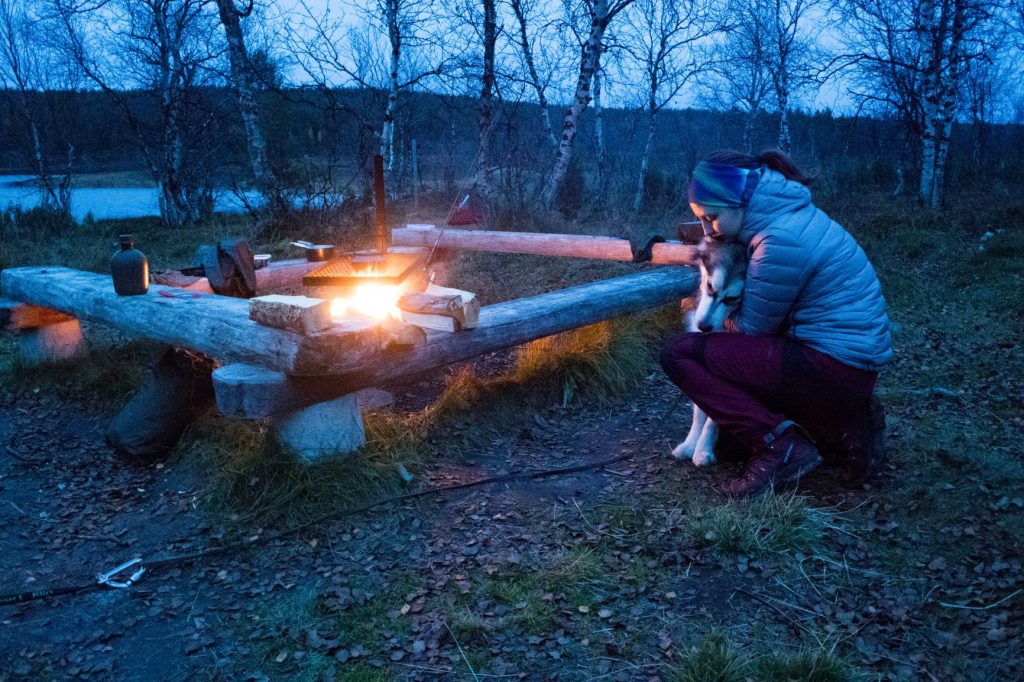
Follow Ella and her adventures on Instagram at ellashiking!
Read more
- Ella’s earlier post: Trekking at Urho Kekkonen National Park, part 1
- Ella’s earlier post: Overnight visit to Isojärvi National Park in winter
- Oittaa in Espoo is an example of a place where you can train skijoring with your dog in winter.
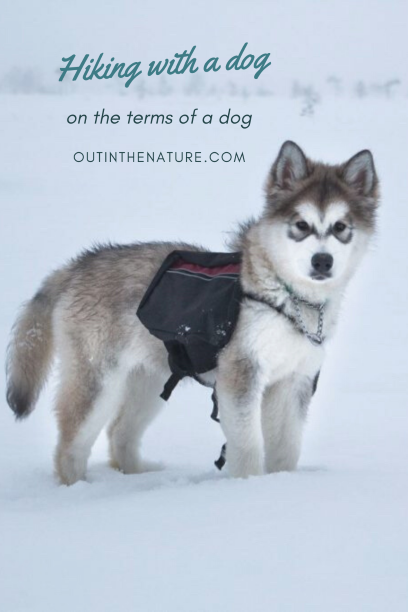

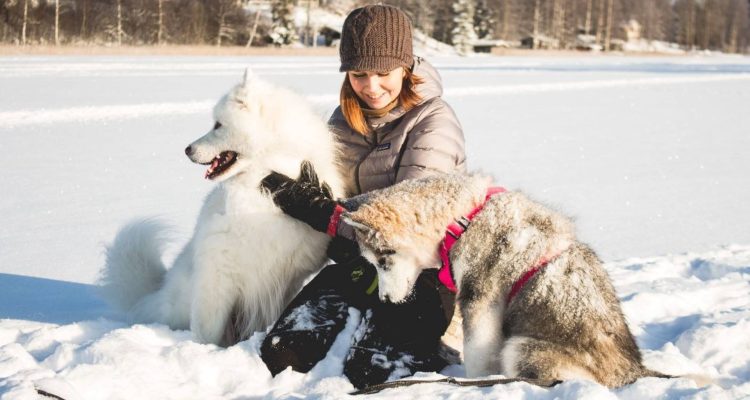
I’ve been doing a lot of hiking recently. I think all I’m missing is the dog. I have to say that these dogs are beautiful, and I actually learned a lot about hiking with dogs. Great tips, it looks like they really enjoy the outdoors
Loving this post! I’m hoping to go hiking with my dog at some point but she’s quite small so I wasn’t really sure where to go or what to bring with me. Thanks for the tips!
I love dogs and I love hiking, but I have yet to combine the two. There seem to be a lot of things to consider. Thank you for this very helpful post.
Oh my god, those dogs are the cutest !! Great advises to make sure they enjoy as much as we do !
Enjoyed reading your article! So good you have built such a good bond with Vilma and by the way she looks lovely! I used to hike for many years but never hiked with a dog! I liked that this article points out the respect we should treat a dog on a hike!
Such an amazing and insightful blog post! Thank you so so much! For sharing!
Haha! Viima looks like the perfect companion when your partner/ friends ditch you (and otherwise too..lol). Very well written!
I think it’s a great idea to have dogs on a leash or at least well behaved pups to be close enough to prevent disruption to the wildlife. More countries should do this I think, especially during bird breeding season or in Spring when there are a lot of fledglings. Thanks for sharing your experience.
New #LifeGoal alert! This is awesome! I never thought hiking could be better, but having your dogs with you is definitely a step up. Love all your tips, thanks so much for opening my eyes to the possibility 🙂
I love hiking with my dog. I learned a lot from reading your tips about how to better hike and camp with my dog. These are intelligent, helpful ideas –real pro tips.